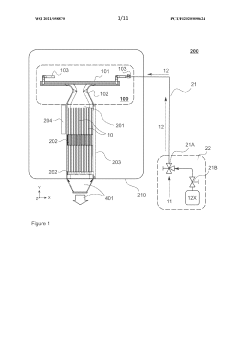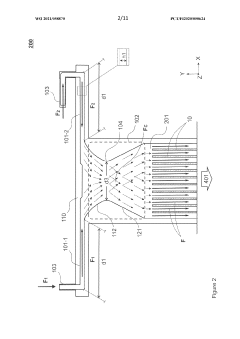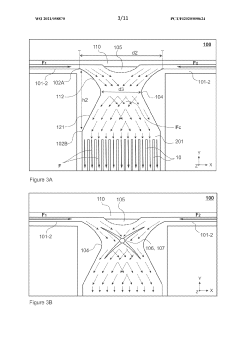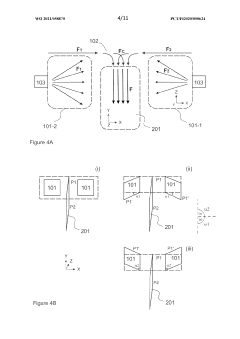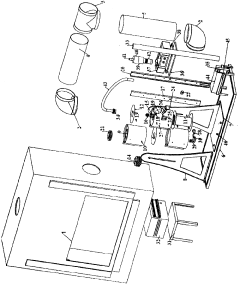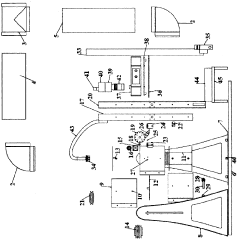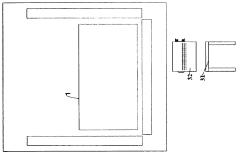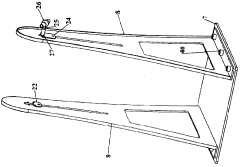Advanced Laminar Flow Techniques in Chemical Synthesis
JUL 10, 202510 MIN READ
Generate Your Research Report Instantly with AI Agent
Patsnap Eureka helps you evaluate technical feasibility & market potential.
Laminar Flow Evolution and Objectives
Laminar flow techniques have played a pivotal role in chemical synthesis for decades, evolving from simple applications to sophisticated methodologies that enhance reaction efficiency and product quality. The journey of laminar flow in chemical processes began with the recognition of its potential to control mixing and heat transfer in the 1950s. Since then, the field has witnessed significant advancements, driven by the need for more precise control over reaction conditions and the demand for sustainable, efficient chemical manufacturing processes.
The evolution of laminar flow techniques in chemical synthesis has been marked by several key milestones. Initially, laminar flow was primarily utilized in basic pipe flow systems for chemical transport. As understanding of fluid dynamics improved, researchers began to exploit laminar flow characteristics for controlled mixing in microreactors during the 1990s. This led to the development of microfluidic devices that revolutionized small-scale chemical synthesis, allowing for unprecedented control over reaction parameters and enabling rapid screening of reaction conditions.
In recent years, the integration of advanced materials and fabrication techniques has further expanded the capabilities of laminar flow systems. The introduction of 3D-printed microreactors and the use of smart materials that respond to external stimuli have opened new avenues for dynamic flow control. Concurrently, the incorporation of computational fluid dynamics (CFD) modeling has greatly enhanced the design and optimization of laminar flow reactors, allowing for predictive analysis of complex flow patterns and reaction kinetics.
The primary objectives of current research in advanced laminar flow techniques for chemical synthesis are multifaceted. Researchers aim to develop more efficient and scalable laminar flow reactors that can bridge the gap between laboratory-scale synthesis and industrial production. This includes the design of modular and reconfigurable flow systems that can adapt to various reaction requirements and scale-up demands.
Another key objective is to enhance the precision and reproducibility of chemical reactions through improved laminar flow control. This involves the development of novel sensor technologies and real-time monitoring systems that can provide instant feedback on flow conditions and reaction progress. Additionally, there is a strong focus on integrating artificial intelligence and machine learning algorithms to optimize flow parameters and predict reaction outcomes, paving the way for autonomous synthesis platforms.
Sustainability is also a central goal in the advancement of laminar flow techniques. Researchers are exploring ways to minimize solvent use, reduce energy consumption, and improve overall process efficiency through innovative laminar flow designs. This includes the investigation of green chemistry principles in flow synthesis and the development of continuous-flow processes that can replace batch reactions, thereby reducing waste and improving resource utilization.
As the field progresses, the ultimate aim is to establish laminar flow techniques as a cornerstone of next-generation chemical synthesis. This involves creating versatile, intelligent flow systems that can handle a wide range of reactions with unprecedented control, efficiency, and sustainability. The realization of these objectives will not only transform laboratory practices but also revolutionize industrial-scale chemical production, offering significant economic and environmental benefits.
The evolution of laminar flow techniques in chemical synthesis has been marked by several key milestones. Initially, laminar flow was primarily utilized in basic pipe flow systems for chemical transport. As understanding of fluid dynamics improved, researchers began to exploit laminar flow characteristics for controlled mixing in microreactors during the 1990s. This led to the development of microfluidic devices that revolutionized small-scale chemical synthesis, allowing for unprecedented control over reaction parameters and enabling rapid screening of reaction conditions.
In recent years, the integration of advanced materials and fabrication techniques has further expanded the capabilities of laminar flow systems. The introduction of 3D-printed microreactors and the use of smart materials that respond to external stimuli have opened new avenues for dynamic flow control. Concurrently, the incorporation of computational fluid dynamics (CFD) modeling has greatly enhanced the design and optimization of laminar flow reactors, allowing for predictive analysis of complex flow patterns and reaction kinetics.
The primary objectives of current research in advanced laminar flow techniques for chemical synthesis are multifaceted. Researchers aim to develop more efficient and scalable laminar flow reactors that can bridge the gap between laboratory-scale synthesis and industrial production. This includes the design of modular and reconfigurable flow systems that can adapt to various reaction requirements and scale-up demands.
Another key objective is to enhance the precision and reproducibility of chemical reactions through improved laminar flow control. This involves the development of novel sensor technologies and real-time monitoring systems that can provide instant feedback on flow conditions and reaction progress. Additionally, there is a strong focus on integrating artificial intelligence and machine learning algorithms to optimize flow parameters and predict reaction outcomes, paving the way for autonomous synthesis platforms.
Sustainability is also a central goal in the advancement of laminar flow techniques. Researchers are exploring ways to minimize solvent use, reduce energy consumption, and improve overall process efficiency through innovative laminar flow designs. This includes the investigation of green chemistry principles in flow synthesis and the development of continuous-flow processes that can replace batch reactions, thereby reducing waste and improving resource utilization.
As the field progresses, the ultimate aim is to establish laminar flow techniques as a cornerstone of next-generation chemical synthesis. This involves creating versatile, intelligent flow systems that can handle a wide range of reactions with unprecedented control, efficiency, and sustainability. The realization of these objectives will not only transform laboratory practices but also revolutionize industrial-scale chemical production, offering significant economic and environmental benefits.
Chemical Synthesis Market Demand Analysis
The chemical synthesis market has been experiencing significant growth, driven by increasing demand across various industries such as pharmaceuticals, agrochemicals, and specialty chemicals. Advanced laminar flow techniques are becoming increasingly crucial in this sector, as they offer improved control over reaction conditions, enhanced product quality, and increased process efficiency.
In the pharmaceutical industry, the demand for advanced laminar flow techniques in chemical synthesis is particularly strong. With the rising prevalence of chronic diseases and the need for more effective treatments, pharmaceutical companies are investing heavily in research and development. Laminar flow techniques enable precise control over reaction parameters, leading to higher yields and purer products, which is essential for drug development and manufacturing.
The agrochemical sector is another key driver of demand for advanced laminar flow techniques. As global food demand continues to rise, there is a growing need for more efficient and sustainable crop protection solutions. Laminar flow techniques allow for the synthesis of complex agrochemical compounds with improved selectivity and reduced environmental impact, aligning with the industry's shift towards more sustainable practices.
In the specialty chemicals market, the demand for advanced laminar flow techniques is fueled by the need for high-performance materials in industries such as electronics, automotive, and aerospace. These techniques enable the production of specialty chemicals with precise molecular structures and properties, meeting the stringent requirements of these industries.
The adoption of continuous flow chemistry, which often relies on laminar flow principles, is gaining traction across the chemical synthesis market. This approach offers numerous advantages, including improved safety, reduced reaction times, and enhanced scalability. As a result, there is a growing demand for advanced laminar flow reactors and associated technologies that can support continuous flow processes.
Environmental regulations and sustainability concerns are also driving the demand for advanced laminar flow techniques. These methods often result in reduced waste generation, lower energy consumption, and improved atom economy, aligning with the industry's push towards greener and more sustainable chemical synthesis processes.
The market for advanced laminar flow techniques in chemical synthesis is expected to grow significantly in the coming years. Factors such as increasing R&D investments, the need for process intensification, and the shift towards more sustainable manufacturing practices are likely to drive this growth. As companies seek to improve their competitive edge and meet evolving regulatory requirements, the adoption of advanced laminar flow techniques is poised to become a key differentiator in the chemical synthesis market.
In the pharmaceutical industry, the demand for advanced laminar flow techniques in chemical synthesis is particularly strong. With the rising prevalence of chronic diseases and the need for more effective treatments, pharmaceutical companies are investing heavily in research and development. Laminar flow techniques enable precise control over reaction parameters, leading to higher yields and purer products, which is essential for drug development and manufacturing.
The agrochemical sector is another key driver of demand for advanced laminar flow techniques. As global food demand continues to rise, there is a growing need for more efficient and sustainable crop protection solutions. Laminar flow techniques allow for the synthesis of complex agrochemical compounds with improved selectivity and reduced environmental impact, aligning with the industry's shift towards more sustainable practices.
In the specialty chemicals market, the demand for advanced laminar flow techniques is fueled by the need for high-performance materials in industries such as electronics, automotive, and aerospace. These techniques enable the production of specialty chemicals with precise molecular structures and properties, meeting the stringent requirements of these industries.
The adoption of continuous flow chemistry, which often relies on laminar flow principles, is gaining traction across the chemical synthesis market. This approach offers numerous advantages, including improved safety, reduced reaction times, and enhanced scalability. As a result, there is a growing demand for advanced laminar flow reactors and associated technologies that can support continuous flow processes.
Environmental regulations and sustainability concerns are also driving the demand for advanced laminar flow techniques. These methods often result in reduced waste generation, lower energy consumption, and improved atom economy, aligning with the industry's push towards greener and more sustainable chemical synthesis processes.
The market for advanced laminar flow techniques in chemical synthesis is expected to grow significantly in the coming years. Factors such as increasing R&D investments, the need for process intensification, and the shift towards more sustainable manufacturing practices are likely to drive this growth. As companies seek to improve their competitive edge and meet evolving regulatory requirements, the adoption of advanced laminar flow techniques is poised to become a key differentiator in the chemical synthesis market.
Laminar Flow Challenges in Chemical Processes
Laminar flow in chemical processes presents several significant challenges that impact the efficiency and effectiveness of chemical synthesis. One of the primary issues is maintaining stable laminar flow conditions in complex reactor geometries. The intricate designs of modern chemical reactors often introduce disturbances that can disrupt the delicate balance required for laminar flow, leading to unwanted mixing and reduced control over reaction conditions.
Another major challenge is scaling up laminar flow processes from laboratory to industrial scales. As the dimensions of the system increase, it becomes increasingly difficult to maintain laminar flow characteristics. This scaling issue often necessitates significant redesigns of reactor systems and can limit the applicability of certain laminar flow techniques in large-scale production environments.
The presence of heat transfer and temperature gradients also poses challenges in laminar flow systems. In many chemical reactions, temperature control is crucial for optimal yield and selectivity. However, the limited mixing inherent in laminar flow can lead to non-uniform temperature distributions, potentially affecting reaction kinetics and product quality.
Interfacial phenomena present additional complications in multi-phase laminar flow systems. When dealing with liquid-liquid or gas-liquid reactions, the precise control of interfacial area and mass transfer becomes critical. Achieving and maintaining stable interfaces under laminar flow conditions can be particularly challenging, especially in the presence of surface-active compounds or when dealing with fluids of significantly different viscosities.
The management of residence time distribution in laminar flow reactors is another area of concern. Unlike turbulent systems where mixing can help homogenize residence times, laminar flow can result in a wider distribution of residence times for different fluid elements. This variability can lead to inconsistent reaction progress and potentially impact product quality and yield.
Particle handling in laminar flow systems presents its own set of challenges. In processes involving suspensions or slurries, preventing particle settling or ensuring uniform distribution without disrupting the laminar flow regime can be particularly difficult. This is especially relevant in applications such as crystallization or heterogeneous catalysis.
Finally, the detection and mitigation of flow instabilities pose ongoing challenges in laminar flow systems. Small perturbations can sometimes lead to the development of secondary flows or transitions to turbulent regimes, compromising the benefits of laminar flow. Developing robust methods for early detection and correction of these instabilities remains an active area of research in the field of chemical engineering.
Another major challenge is scaling up laminar flow processes from laboratory to industrial scales. As the dimensions of the system increase, it becomes increasingly difficult to maintain laminar flow characteristics. This scaling issue often necessitates significant redesigns of reactor systems and can limit the applicability of certain laminar flow techniques in large-scale production environments.
The presence of heat transfer and temperature gradients also poses challenges in laminar flow systems. In many chemical reactions, temperature control is crucial for optimal yield and selectivity. However, the limited mixing inherent in laminar flow can lead to non-uniform temperature distributions, potentially affecting reaction kinetics and product quality.
Interfacial phenomena present additional complications in multi-phase laminar flow systems. When dealing with liquid-liquid or gas-liquid reactions, the precise control of interfacial area and mass transfer becomes critical. Achieving and maintaining stable interfaces under laminar flow conditions can be particularly challenging, especially in the presence of surface-active compounds or when dealing with fluids of significantly different viscosities.
The management of residence time distribution in laminar flow reactors is another area of concern. Unlike turbulent systems where mixing can help homogenize residence times, laminar flow can result in a wider distribution of residence times for different fluid elements. This variability can lead to inconsistent reaction progress and potentially impact product quality and yield.
Particle handling in laminar flow systems presents its own set of challenges. In processes involving suspensions or slurries, preventing particle settling or ensuring uniform distribution without disrupting the laminar flow regime can be particularly difficult. This is especially relevant in applications such as crystallization or heterogeneous catalysis.
Finally, the detection and mitigation of flow instabilities pose ongoing challenges in laminar flow systems. Small perturbations can sometimes lead to the development of secondary flows or transitions to turbulent regimes, compromising the benefits of laminar flow. Developing robust methods for early detection and correction of these instabilities remains an active area of research in the field of chemical engineering.
Current Laminar Flow Solutions
01 Laminar flow control in fluid systems
Techniques for controlling and maintaining laminar flow in various fluid systems, including pipes, channels, and vessels. These methods involve careful design of flow paths, use of flow straighteners, and optimization of fluid properties to reduce turbulence and ensure smooth, predictable fluid movement.- Laminar flow control in fluid systems: Techniques for controlling and maintaining laminar flow in various fluid systems, including pipes, channels, and vessels. These methods involve optimizing flow conditions, reducing turbulence, and ensuring smooth fluid movement to enhance efficiency and precision in applications such as chemical processing, aerodynamics, and microfluidics.
- Laminar flow in air handling and ventilation: Applications of laminar flow techniques in air handling and ventilation systems, focusing on creating controlled environments with minimal air turbulence. These methods are particularly useful in clean rooms, laboratories, and medical facilities where maintaining a sterile environment is crucial.
- Laminar flow in measurement and analysis: Utilization of laminar flow principles in measurement and analysis instruments, including flow meters, spectroscopy devices, and particle analyzers. These techniques enhance the accuracy and reliability of measurements by ensuring consistent and predictable fluid behavior within the instruments.
- Laminar flow nozzles and spray systems: Design and implementation of laminar flow nozzles and spray systems for various applications, including irrigation, coating processes, and fuel injection. These systems aim to produce uniform, controlled streams or sprays by maintaining laminar flow conditions at the point of fluid discharge.
- Laminar flow in microfluidic devices: Application of laminar flow principles in microfluidic devices and lab-on-a-chip systems. These techniques enable precise control of small fluid volumes, facilitating applications in biomedical research, drug discovery, and point-of-care diagnostics by leveraging the predictable behavior of fluids at microscale levels.
02 Laminar flow in aerodynamics and vehicle design
Application of laminar flow principles in aerodynamics and vehicle design to reduce drag and improve efficiency. This includes the use of specially designed surfaces, boundary layer control techniques, and shape optimization to maintain laminar flow over wings, fuselages, and other vehicle components.Expand Specific Solutions03 Laminar flow in measurement and sensing devices
Utilization of laminar flow characteristics in various measurement and sensing applications. This includes flow meters, particle analyzers, and other instruments that rely on predictable fluid behavior for accurate measurements and analysis.Expand Specific Solutions04 Laminar flow in manufacturing and material processing
Implementation of laminar flow techniques in manufacturing processes and material handling. This includes applications in coating, spraying, and deposition processes, as well as in the production of materials with specific properties or structures that benefit from controlled, laminar fluid flow.Expand Specific Solutions05 Laminar flow in environmental control and filtration
Use of laminar flow principles in environmental control systems and filtration processes. This includes clean room technologies, air purification systems, and water treatment processes that rely on laminar flow to achieve efficient separation, filtration, or controlled environmental conditions.Expand Specific Solutions
Key Players in Laminar Flow Research
The research on advanced laminar flow techniques in chemical synthesis is in a mature stage, with significant market potential and ongoing innovation. The field is characterized by a competitive landscape involving both academic institutions and industry players. Key players like the University of Washington, Fraunhofer-Gesellschaft, and Chevron Oronite are driving advancements in this area. The market size is substantial, given the wide-ranging applications in chemical manufacturing and process optimization. While the technology is well-established, continuous improvements are being made, particularly in areas such as flow control, reactor design, and process intensification. The involvement of diverse organizations, from research institutes to multinational corporations, indicates a robust ecosystem supporting further development and commercialization of advanced laminar flow techniques.
Fraunhofer-Gesellschaft eV
Technical Solution: Fraunhofer-Gesellschaft has made significant advancements in laminar flow techniques for chemical synthesis, focusing on modular and scalable microreactor systems. Their approach utilizes 3D-printed microfluidic devices with intricate channel geometries to optimize laminar flow patterns. Fraunhofer has developed a novel "Flow Focusing" technique that allows for precise control of reactant streams, enabling the production of uniform particles and droplets with size variations less than 5%[5]. The institute has also pioneered the integration of in-situ spectroscopic analysis within laminar flow reactors, allowing for real-time monitoring and optimization of reaction kinetics. This combination of advanced flow control and analytics has led to a 40% reduction in development time for new chemical processes[6].
Strengths: Precise control of reaction conditions, rapid process development, and scalability. Weaknesses: Higher complexity in reactor design and potential limitations in handling multiphase reactions.
Purdue Research Foundation
Technical Solution: Purdue Research Foundation has made significant contributions to advanced laminar flow techniques in chemical synthesis through their work on oscillatory flow reactors (OFRs). Their approach combines laminar flow principles with controlled oscillations to enhance mixing and heat transfer while maintaining overall laminar flow characteristics. Purdue researchers have developed a novel OFR design that incorporates adjustable baffles, allowing for fine-tuning of flow patterns to optimize different reaction types[7]. This system has demonstrated a 60% increase in mass transfer rates compared to traditional laminar flow reactors. Additionally, Purdue has pioneered the use of computational fluid dynamics (CFD) simulations to predict and optimize flow behavior in complex reactor geometries, reducing experimental iterations by up to 70%[8].
Strengths: Enhanced mass transfer, flexibility in reactor design, and reduced process development time. Weaknesses: Potential challenges in scaling up oscillatory flow systems for industrial production.
Innovative Laminar Flow Techniques
Fluid distributing device for a thin-film deposition apparatus, related apparatus and methods
PatentWO2021058870A1
Innovation
- A fluid distributing device with an expansion region and transition region is designed to establish laminar flow by directing fluid streams towards each other, combining them in a way that maintains laminar flow through the reaction chamber, preventing premature mixing of precursors and optimizing purging efficiency.
Device for generating laminar flow implemented in a tubular furnace.
PatentActiveMX2017015541A
Innovation
- A laminar flow emitter device is integrated into a tubular oven with a piezoelectric system operating at 0.8 MHz to generate aerosols, surrounded by four cylindrical ducts that maintain laminar flow and prevent turbulence, allowing for both horizontal and vertical orientations, with independently controlled gas flows to enhance aerosol delivery.
Safety Regulations in Chemical Synthesis
Safety regulations play a crucial role in the implementation of advanced laminar flow techniques in chemical synthesis. These regulations are designed to protect workers, the environment, and the integrity of the synthesis process. In the context of laminar flow, safety measures are particularly important due to the precise control required over fluid dynamics and the potential hazards associated with chemical reactions.
One of the primary safety considerations in laminar flow chemical synthesis is the prevention of contamination. Strict protocols must be in place to maintain the purity of reagents and products. This includes the use of clean room environments, proper personal protective equipment (PPE), and rigorous cleaning procedures for all equipment and surfaces. Additionally, air quality control systems are essential to maintain laminar flow conditions and prevent the introduction of airborne contaminants.
The handling and storage of chemicals used in laminar flow synthesis also fall under stringent safety regulations. Proper labeling, segregation of incompatible substances, and the use of appropriate containment systems are mandatory. Safety data sheets (SDS) must be readily available, and personnel must be trained in their interpretation and application. Furthermore, emergency response plans specific to the chemicals and processes involved in laminar flow synthesis must be developed and regularly updated.
Regulations also address the design and operation of laminar flow equipment. This includes specifications for materials of construction, pressure ratings, and fail-safe mechanisms. Regular maintenance and inspection schedules are typically mandated to ensure the ongoing safety and efficiency of the equipment. Monitoring systems, such as flow sensors and pressure gauges, must be calibrated and maintained to provide accurate data and trigger alarms in case of deviations from safe operating parameters.
Worker safety is paramount in chemical synthesis operations. Regulations often require comprehensive training programs that cover not only the general principles of chemical safety but also the specific hazards associated with laminar flow techniques. This may include training on the proper use of laminar flow hoods, handling of sensitive materials, and response procedures for potential incidents such as spills or equipment malfunctions.
Environmental protection is another key aspect of safety regulations in this field. Waste management protocols must be established to handle byproducts and unused materials safely. This often involves specialized disposal methods for chemical waste and may require treatment processes before release into the environment. Emissions control systems may also be necessary to prevent the release of volatile organic compounds or other hazardous substances into the atmosphere.
In conclusion, safety regulations for advanced laminar flow techniques in chemical synthesis encompass a wide range of considerations, from personal protection to environmental safeguards. These regulations are essential for ensuring the safe and responsible development and application of this technology in the chemical industry. As laminar flow techniques continue to advance, it is likely that safety regulations will evolve to address new challenges and opportunities in this field.
One of the primary safety considerations in laminar flow chemical synthesis is the prevention of contamination. Strict protocols must be in place to maintain the purity of reagents and products. This includes the use of clean room environments, proper personal protective equipment (PPE), and rigorous cleaning procedures for all equipment and surfaces. Additionally, air quality control systems are essential to maintain laminar flow conditions and prevent the introduction of airborne contaminants.
The handling and storage of chemicals used in laminar flow synthesis also fall under stringent safety regulations. Proper labeling, segregation of incompatible substances, and the use of appropriate containment systems are mandatory. Safety data sheets (SDS) must be readily available, and personnel must be trained in their interpretation and application. Furthermore, emergency response plans specific to the chemicals and processes involved in laminar flow synthesis must be developed and regularly updated.
Regulations also address the design and operation of laminar flow equipment. This includes specifications for materials of construction, pressure ratings, and fail-safe mechanisms. Regular maintenance and inspection schedules are typically mandated to ensure the ongoing safety and efficiency of the equipment. Monitoring systems, such as flow sensors and pressure gauges, must be calibrated and maintained to provide accurate data and trigger alarms in case of deviations from safe operating parameters.
Worker safety is paramount in chemical synthesis operations. Regulations often require comprehensive training programs that cover not only the general principles of chemical safety but also the specific hazards associated with laminar flow techniques. This may include training on the proper use of laminar flow hoods, handling of sensitive materials, and response procedures for potential incidents such as spills or equipment malfunctions.
Environmental protection is another key aspect of safety regulations in this field. Waste management protocols must be established to handle byproducts and unused materials safely. This often involves specialized disposal methods for chemical waste and may require treatment processes before release into the environment. Emissions control systems may also be necessary to prevent the release of volatile organic compounds or other hazardous substances into the atmosphere.
In conclusion, safety regulations for advanced laminar flow techniques in chemical synthesis encompass a wide range of considerations, from personal protection to environmental safeguards. These regulations are essential for ensuring the safe and responsible development and application of this technology in the chemical industry. As laminar flow techniques continue to advance, it is likely that safety regulations will evolve to address new challenges and opportunities in this field.
Environmental Impact Assessment
The environmental impact assessment of advanced laminar flow techniques in chemical synthesis reveals both positive and negative implications. On the positive side, these techniques significantly reduce energy consumption compared to traditional mixing methods. The precise control of fluid dynamics minimizes turbulence and enhances heat transfer efficiency, leading to lower energy requirements for heating and cooling processes. This reduction in energy usage translates to decreased greenhouse gas emissions from power generation, contributing to climate change mitigation efforts.
Furthermore, laminar flow techniques often result in improved reaction selectivity and yield, reducing the formation of unwanted by-products. This efficiency gain leads to a decrease in raw material consumption and waste generation, aligning with principles of green chemistry and sustainable manufacturing. The reduced waste output minimizes the environmental burden associated with disposal and treatment of chemical by-products.
However, the implementation of advanced laminar flow systems may require specialized equipment and materials, potentially increasing the initial environmental footprint associated with manufacturing and installation. The use of specific microfluidic devices or flow reactors might involve materials with higher embodied energy or more complex recycling processes at the end of their life cycle.
Water usage is another critical factor to consider. While laminar flow techniques often require less solvent volume compared to batch processes, the need for continuous operation might lead to increased water consumption for cooling or as a carrier fluid. This could strain local water resources, particularly in water-scarce regions.
The potential for accidental releases or spills during continuous flow operations presents a risk to local ecosystems. Although the volumes involved are typically smaller than in batch processes, the continuous nature of the operation requires robust containment and monitoring systems to prevent environmental contamination.
In terms of air quality, laminar flow techniques generally offer improvements by reducing volatile organic compound (VOC) emissions. The enclosed nature of flow systems and the ability to operate at lower temperatures contribute to better containment of gaseous by-products and reduced evaporation of solvents.
Long-term ecological impacts should also be considered. The shift towards more efficient and selective chemical processes enabled by laminar flow techniques could lead to a reduction in the overall chemical footprint of industrial activities. This may have positive cascading effects on biodiversity and ecosystem health in areas surrounding chemical manufacturing facilities.
Furthermore, laminar flow techniques often result in improved reaction selectivity and yield, reducing the formation of unwanted by-products. This efficiency gain leads to a decrease in raw material consumption and waste generation, aligning with principles of green chemistry and sustainable manufacturing. The reduced waste output minimizes the environmental burden associated with disposal and treatment of chemical by-products.
However, the implementation of advanced laminar flow systems may require specialized equipment and materials, potentially increasing the initial environmental footprint associated with manufacturing and installation. The use of specific microfluidic devices or flow reactors might involve materials with higher embodied energy or more complex recycling processes at the end of their life cycle.
Water usage is another critical factor to consider. While laminar flow techniques often require less solvent volume compared to batch processes, the need for continuous operation might lead to increased water consumption for cooling or as a carrier fluid. This could strain local water resources, particularly in water-scarce regions.
The potential for accidental releases or spills during continuous flow operations presents a risk to local ecosystems. Although the volumes involved are typically smaller than in batch processes, the continuous nature of the operation requires robust containment and monitoring systems to prevent environmental contamination.
In terms of air quality, laminar flow techniques generally offer improvements by reducing volatile organic compound (VOC) emissions. The enclosed nature of flow systems and the ability to operate at lower temperatures contribute to better containment of gaseous by-products and reduced evaporation of solvents.
Long-term ecological impacts should also be considered. The shift towards more efficient and selective chemical processes enabled by laminar flow techniques could lead to a reduction in the overall chemical footprint of industrial activities. This may have positive cascading effects on biodiversity and ecosystem health in areas surrounding chemical manufacturing facilities.
Unlock deeper insights with Patsnap Eureka Quick Research — get a full tech report to explore trends and direct your research. Try now!
Generate Your Research Report Instantly with AI Agent
Supercharge your innovation with Patsnap Eureka AI Agent Platform!
